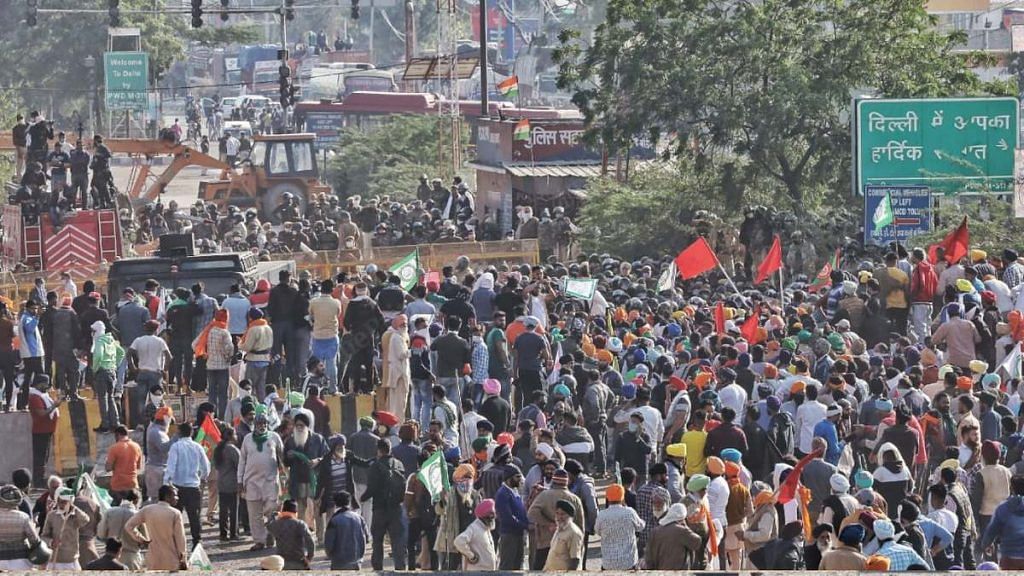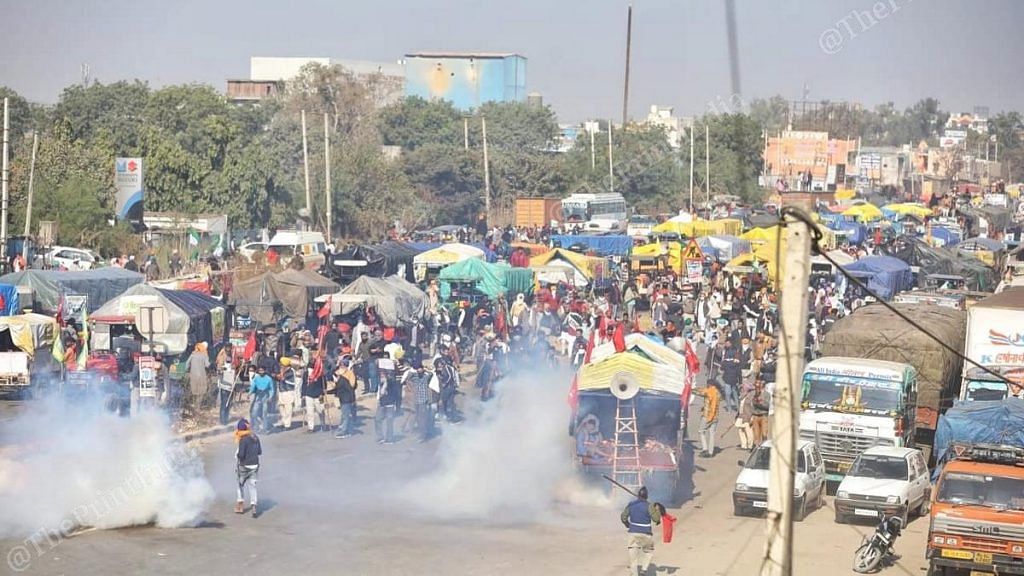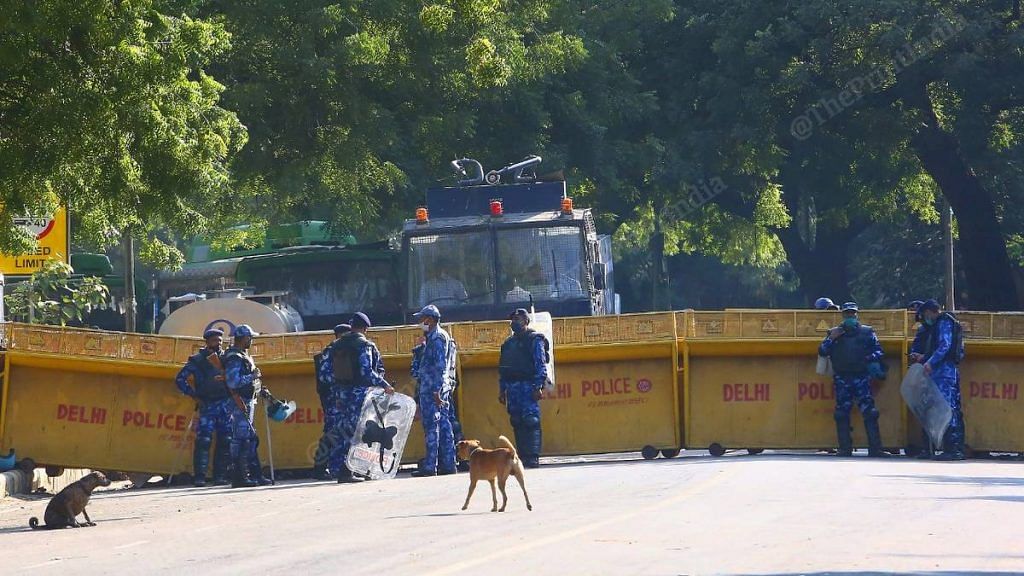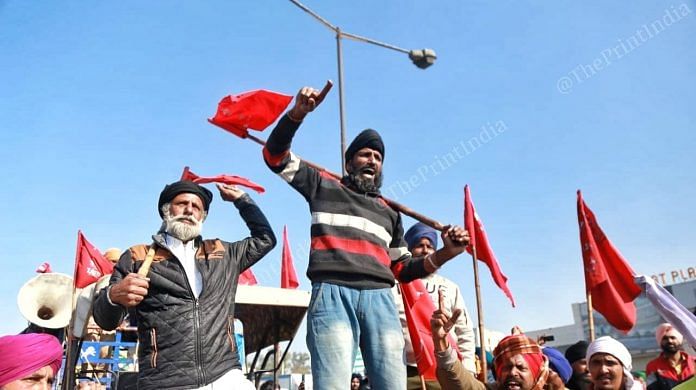Singhu Border/New Delhi: Farmers protesting against the three agriculture laws that the Narendra Modi government passed earlier this year have been allowed to enter Delhi — but only up to the Nirankari Ground in Burari, at the northern edge of the city. But farmers have decided to spend the night at the Singhu Border, and hold a meeting Saturday on whether to move to Burari.
The Centre’s decision to allow them into Delhi was welcomed by supporters of the ‘Delhi Chalo’ march as well as Punjab Chief Minister Amarinder Singh, but it came only after tense scenes ensued through the day at the Singhu border with Haryana in north Delhi.
Water cannons were deployed and multiple rounds of tear gas shells fired by the police at the protesting farmers, who had reached the Singhu border early Friday morning. The police initially asked the farmers to continue their sit-in protest, but not cross over to the Delhi side. To this, farmers said they were only waiting for the remaining protesters to arrive before entering Delhi.

The protests have been on since October, and while the farmers have lifted their long rail blockade in Punjab, they want a complete revocation of the three new farm laws, and are marching to Delhi to demand the same from the central government. The Delhi Police had earlier refused permission for protests at both Ramlila Maidan and Jantar Mantar, citing Covid restrictions. Over 200 protesters were arrested and detained Thursday inside Delhi as well as from roads leading to it.
Also read: Farmer protests are being politicised, but use of force not right, says RSS affiliate
Staying put
Following the Centre’s decision, Eish Singh, Delhi Police PRO, told ThePrint: “After discussion with farmer leaders, the protesting farmers have been permitted inside Delhi to hold peaceful protests at Nirankari Ground, Burari. Delhi Police appeals to them to maintain peace.”
Farmer leaders then told ThePrint that a decision was being taken on whether the farmers will move to Burari or not. After a two-hour-long meeting, farmers decided to spend the night at the border.
“We have decided to spend the night here today at the border. Farmer unions will hold a meeting tomorrow to decide on whether they will move to Burari tomorrow or not,” said Harpal Singh, member of the state organisation committee of the Bharatiya Kisan Union, Haryana.
A senior farmer leader who did not want to be named had earlier said: “Our top leaders are talking to the government authorities. But farmers feel that they should stay here and lock down the borders because that creates pressure on the Centre. If farmers move to Burari, then the government succeeds in sidelining farmers.”
A senior Delhi Police officer, who didn’t wish to be named, added that arrangements at Burari have started. ‘“It all depends on how things turn out, if they agree to come here or not. Law and order is of utmost importance now, especially in the time of Covid,” the officer said.
Won’t be deterred
As the farmers made their way towards the Singhu Border Friday, clashes took place between them and the police at Panipat, Tikri and Bahadurgarh.
By noon, thousands of farmers who had come from Haryana and Punjab on tractors and trucks, through clashes at Sonepat-Panipat, Hansi and the Khanauri border between the two states, sat down just a few feet away from the Delhi border, where the Delhi Police stood behind barricades and barbed wiring. While police continued to make announcements about maintaining social distance and not crossing over to the Delhi side, the farmers said they would move forward in an organised manner.
Farmers ThePrint spoke to said despite the police’s appeals to not cross the border, their goal was to enter the national capital and protest against the three farm laws.
“We crossed nine barriers to come here through Punjab and Haryana. We won’t be deterred in any way. We want these three laws revoked. They have forced these laws on us amid the pandemic, and now they won’t even let us protest,” said Gurdeep Singh from Punjab.
“Why isn’t the Modi government allowing us to enter Delhi? We just want to protest peacefully. They want to force down laws on us; we have the right to protest. What about that?” asked Sukhdev Singh.
Along with the revocation of the three laws, the protesters also said the government should extend minimum support pricing on all crops and stop privatisation of agriculture. However, the Centre had already stated that the MSP regime would not go away.
“If MSP system won’t go, then why don’t the laws mention this? MSP is only on 23 crops. We want MSP on all crops. We want our mandi system to stay and the laws revoked. Only then we will go back,” said Harnam Singh.
Protesters also said with the three new laws, the Modi government is trying to hand over the reins of the country to corporates. “The Centre has sold the country to Ambani and Adani — whether it is railway stations or power plants to now agriculture. We will not allow this,” said Harbhajan Singh.
Also read: Kejriwal’s govt rejects Delhi Police request to convert stadiums into jails for farmers
Police-farmers’ face-off
By 1 pm, as the protesting farmers inched closer and closer to the barricades, the police started firing tear gas shells. In a span of two hours the police fired numerous rounds, and even used water cannons to disperse the protesters. As the protesters ran helter-skelter, they called it an assault on democracy.

“Why are they firing repeated rounds of tear gas shells? If this is not a dictatorship what is?” asked a protester whose name could not be asked as he was running for cover.
Around 3 pm, the Delhi Police assured farmers that they will be allowed to move to the Nirankari Ground in Burari. But things soon got out of control again even as farmer leaders asked protesters to maintain calm. Soon tear gas shells and water cannons were fired again to disperse them, but the protesters uprooted the barbed wires and toppled the barricades.
Half an hour later, as things calmed down again and the tear gas shelling and water cannons stopped, farmer leaders went into a huddle to try and decide whether to take up the government’s offer of moving the protest to Burari.
Delhi still a fortress
Inside Delhi and on its other borders, the security deployment remains heavy.
Police personnel are stationed with barricades on Delhi’s border with Uttar Pradesh at Ghaziabad, to prevent farmers from crossing over. This is why passengers looking to commute between the capital and its suburb faced massive traffic jams.
The Delhi Metro has notified that passengers are allowed to take trains from Delhi to NCR stations, but there “will be no movement of passengers allowed from NCR stations to Delhi till such a time as advised by police authorities”.
On Parliament Street, which connects the seat of the central government with Jantar Mantar and Connaught Place, water cannons, SWAT buses and Delhi Police buses have been stationed. The area in front of the Department of Financial Services office at Patel Chowk, which leads to Jantar Mantar, has been sealed with barricades.

At protest hub Jantar Mantar itself, a large number of police personnel have been deployed, also with water cannons, SWAT buses and Delhi Police buses. The street has been sealed with heavy barricading, and not even media persons are being allowed to go near any of the Jantar Mantar entry/exit points. These points are being guarded by Rapid Action Force personnel and Central Reserve Police Force jawans in riot gear. At ITO, Border Security Force jawans have been deployed.
Meanwhile, the argument between Punjab and Haryana chief ministers, Amarinder Singh and M.L. Khattar, over the protests continued on Twitter, with the Punjab CM accusing Khattar’s government and the police of brutality.
Impressed by remarkable restraint shown by farmers in face of @mlkhattar govt's and Haryana police's brutality. Their exemplary behaviour shows that farmers are not interested in confrontation, they only want to be heard, which is their constitutional right.
— Capt.Amarinder Singh (@capt_amarinder) November 27, 2020
(With inputs from PTI)
Also read: Amarinder Singh urges Centre to immediately hold talks with protesting farmers







Looks more like middlemen who make money in mandi system, real farmers has work to do in the fields, not go foe some useless agitation. Teh mandi system is still there, What is the issue?